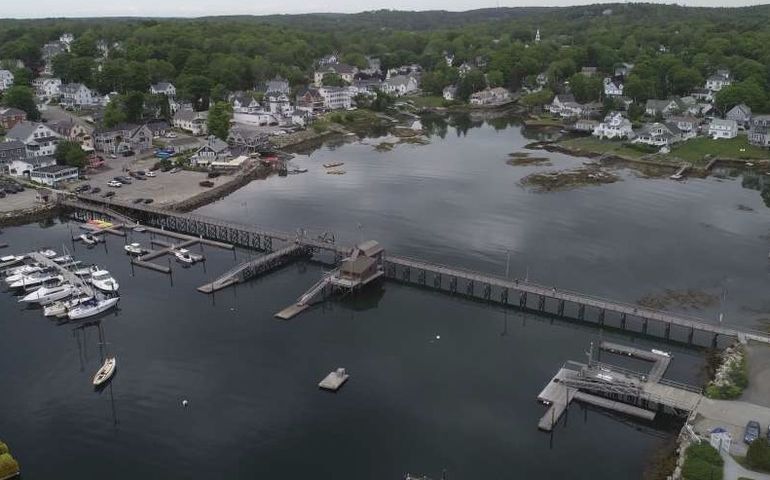Boothbay Harbor debates plans to save historic footbridge
 Courtesy / Town of Boothbay Harbor
Boothbay Harbor’s historic footbridge, a scenic tourist attraction, has been the subject of a planning process to save it from decay and sea level rise.
Courtesy / Town of Boothbay Harbor
Boothbay Harbor’s historic footbridge, a scenic tourist attraction, has been the subject of a planning process to save it from decay and sea level rise.
A historic footbridge in Boothbay Harbor that today is a scenic tourist attraction has been the subject of a planning process to save it from decay and sea level rise.
The Boothbay Harbor Board of Selectmen met Jan. 27 to share the latest design and engineering updates on the bridge with a crowd of about 50 local residents.
“I keep thinking about it as a tourist attraction,” said Selectman Kenneth Fitch. “If you have 3,000 people taking pictures of it, it would be one more thing to bring people to town.”
The bridge has been featured in magazines such as Yankee and Down East.
The original span was built in 1901 by Luther Maddocks for $1,500, according to documents on the town of Boothbay Harbor’s website.
The Maine Memory Network describes Maddocks as a pivotal figure in the construction of various kinds of fish processing plants in Boothbay Harbor in the late 1800s and early 1900s.
The bridge originally had a hand-operated swing span to allow large vessels to reach the head of the harbor. Originally 1,000 feet long, the bridge was at some point shortened by 300 feet by fill to create parking lots at each end.
In the 1970s, the bridge was completely reconstructed. The pilings that hold up the bridge, and the swing span, were repaired in 2017.
The footbridge is considered an important piece of Boothbay Harbor’s infrastructure and character. The structure provides access across the harbor, to the town dock and to private property, and is a prime destination for people who want a scenic view of the harbor.
The U.S. Coast Guard classifies the structure as a movable bridge, although the swing span isn’t currently functioning, according to town documents. Still, the town is responsible for opening the bridge if the need arises.
Among the points to be considered, the board of selectmen said, is whether operation of the swing span should be restored or whether the town should work with the Coast Guard to change the bridge classification, so it doesn’t appear on maritime charts as opening to vessels.
The bridge is also at risk from flooding, given current estimates of sea level rise, the board said. The bridge also doesn’t meet current code compliance requirements related to laws like the Americans with Disabilities Act.
A key consideration, said select chairman Michael Tomko, has been how to strike a balance between safe use of the bridge and its aesthetics.
The town has been working with Baker Design Consultants of Freeport to determine potential design and engineering options, he noted. The results of subsequent storm surge and flood level studies have since been incorporate into the design concept, he said.
Among the considerations are span requirements, overlooks, bridge aesthetics and materials preference.
Additional questions that came up in January, he said, centered on the condition of the pilings that hold up the bridge. Tomko noted that test borings revealed there might be some rot in the pilings.
“I don’t want to rush forward,” said Selectwoman Denise Griffin. “I think we need to get additional engineering information so that we truly understand what the status is of the pilings. No sense building a house on a rotten foundation. But if the foundation’s good, then let’s use what we have and move forward with that.”
Residents at the meeting said additional considerations include the potential need to raise the bridge to mitigate rising seas balanced against scenic impacts of a raised bridge from both shores.
The board agreed the next step is to get a second engineering opinion regarding the bridge’s foundation.
Mainebiz web partners
In Portland, pier owners have found that the pilings are only rotting above the mud they sit in - due to worms and other organisms - so they pull them, flip them and reuse them upside down. As to sea level, put pontoons under the bridge supports so they will rise and fall with the changing tides. All it takes is some creative thinking and problem solving. Also consider using UMO/USM composites for a very long life.










2 Comments